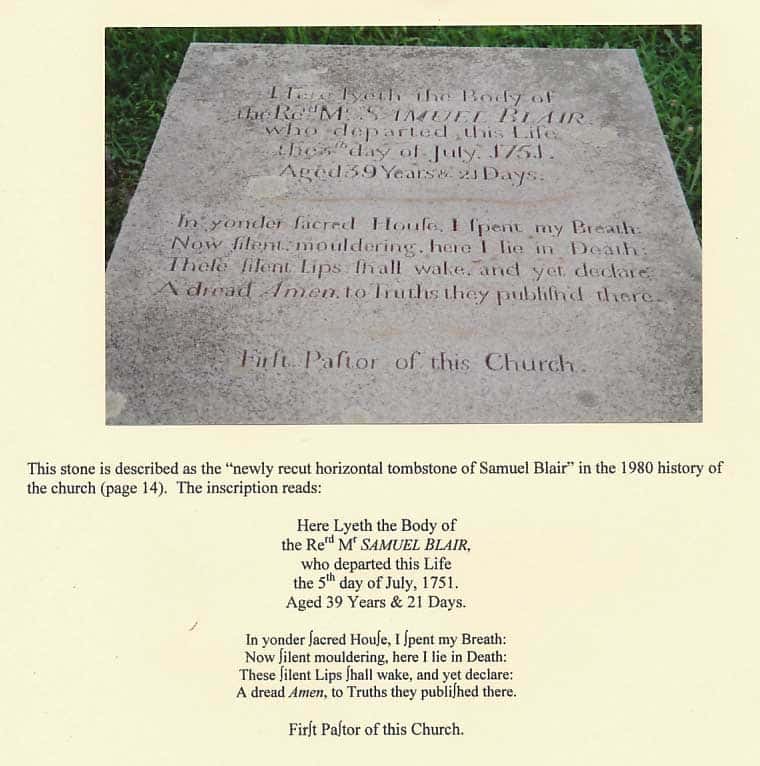He Lived Holy and Died Joyful
The Presbyterian preacher and pastor didn’t make it to age forty. But his almost four decades was filled with work for the Savior in His church.
Our focus for This Day in Presbyterian History is Samuel Blair. Born June 14, 1712 in Ireland, Samuel traveled to America when he was quite young. He received his classical and theological education in the school of the Rev. William Tennent, Sr. at Neshaminy, Bucks County, Pennsylvania, a school which later became celebrated as the Log College. When he finished his training, he was licensed to preach at Abingdon, Pennsylvania by the Presbytery of Philadelphia on November 9, 1733.
For five years, he labored as a pastor in a double charge in the Presbyterian churches in Middleton and Shrewsbury, New Jersey. The people of those congregations were said to be very irreligious. Not much spiritual fruit was registered in his ministry among them. But then a call came from Faggs Manor Presbyterian Church in eastern Pennsylvania. The Presbytery of New Brunswick, of which he was a member, advised him to accept that call, as they were convinced that a wider field of usefulness would be found there. To Faggs Manor then in 1739, Samuel Blair went, and after one year, he began his ministry in 1740. Samuel Blair would be the first pastor they had, even though they had been in existence for ten years.
Preaching to a congregation in which Blair later on characterized as “religion lay as it was a-dying,” the Holy Spirit began after four months a spiritual awakening in their hearts and minds which later on would be part of the first great awakening in the colonies. Faggs Manor Presbyterian would be the middle location of that awakening which took place from Massachusetts to Georgia.
The same year of 1740, on two occasions in May and November, evangelist George Whitefield would preach at Faggs Manor Presbyterian Church as a guest evangelist. This author has stood many times on the property of this congregation at approximately the same location where this spiritual awakening took place. He has on many a day imagined in his mind’s eye the twelve thousand people in attendance responding in repentance and faith at the powerful peaching of the Word of God. And Samuel Blair himself went around the colonies, preaching the same good news of eternal life, extending that which the Spirit of God began in earnest that year.
But conversions to Christ did not stop in Blair’s ministry. Seeing the effect on his life and ministry from the log college, Samuel Blair began his own training station for godly young men. Some of the most illustrious “scholars, preachers, pastors, and patriots” became “a noble company, a goodly fellowship, showing the Church what manner of men the apostles and martyrs were.” (Alfred Nevin, Encyclopedia of the Presbyterian Church, p. 79.)
Involved in the beginnings of the College of New Jersey as a trustee, he took an active part in that school of the prophets. Remember, travel in those days involved long hours on horseback. It was one hundred miles from the church to the college. On one of those long and tiring trips, his health broke and he died on June 5, 1751 at the age of 39. Nevin sums up his life by stating “he spoke as he believed, he practiced what he preached, he lived holy, and he died joyfully.” (Nevin, p. 79)
Words to Live By:
Evangelism and equipping. The two go together, in that our Savior in His Great Commission commanded us to “go and make disciples.” Don’t misread it to say, “go and make decisions.” Biblically, disciples are made, not born.
Note: Faggs Manor Presbyterian Church is the second oldest Presbyterian Church in America congregation, having been organized in 1730. It is now called simply Manor Presbyterian Church.
Samuel Blair’s gravestone:
Tags: Born June, George Whitefield, Log College, New Jersey, Presbyterian Church, Samuel Blair, William Tennent


No comments
Comments feed for this article